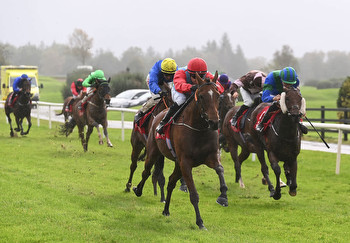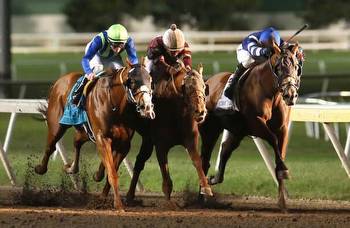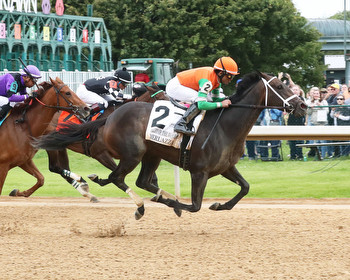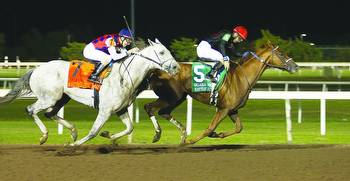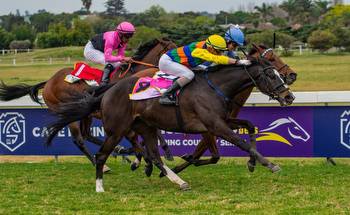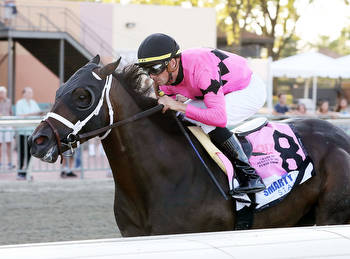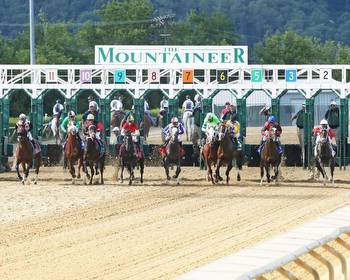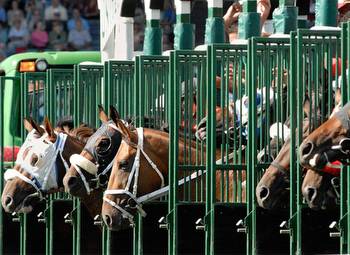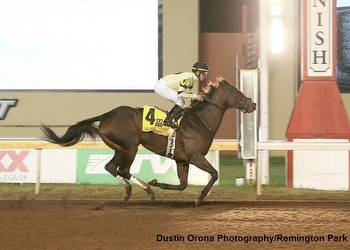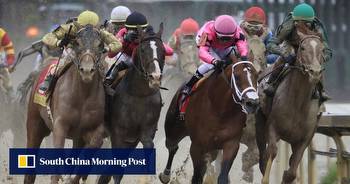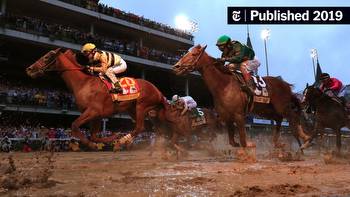Oklahoma The Only State To Adopt Category 1 Horse Racing Rules
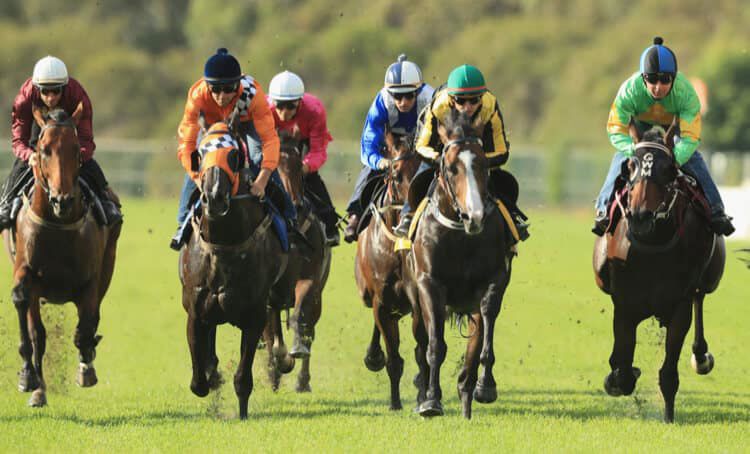
In a $34,000 maiden special weight race at Horseshoe Indianapolis on Sept. 20, a Mark Casse-trained horse by the name of Livi Me Dreaming moved inside at the first turn. A collision between a group of horses positioned behind her ensued, but Livi Me Dreaming avoided any contact with them and coasted to victory by more than a length.
Four days later, at Oklahoma’s Remington Park, How Did He Do That overcame 44/1 odds to win a three-way photo finish in the Grade 3, $400,000 Oklahoma Derby after veering slightly outside and initiating contact with the horse to his right in the homestretch.
There were objections lodged in both races. Can anyone guess which winner was taken down?
Believe it or not, it was Livi Me Dreaming, who was demoted to ninth place by the track’s stewards for allegedly cutting off the horse that “caused the pile-up.” The horse’s trainer, Casse, was firmly among the disbelievers, , “I’ve been doing this over 40 years, have had probably 100 horses DQ’d. By far the worse (sic) call I have ever had against us.”
But down at Remington, How Did He Do That’s victory stood, largely because Oklahoma is the only North American racing jurisdiction that has adopted Category 1 rules for interference, which is the standard in the rest of the world. In North America, stewards typically abide by Category 2 rules, which allow for more interpretive leeway and, in the opinion of critics, debatable — if not downright inexplicable — decisions.
Two differing philosophies
Kelly Cathey is the current director of racing at Remington Park, but he was the executive director of the Oklahoma Horse Racing Commission (OHRC) back when it took the bold step of implementing Category 1 interference rules in 2022.
As Cathey explains it, “In Category 2, it’s whether you interfered and the stewards think you cost a horse a placing. Let’s say you bump a horse on the first turn. There’s always some bumping there. Coming around, your horse continues to run and wins by 2-1/2 lengths. Say the horse he bumped runs fifth and it’s the steward’s opinion that the winner cost a horse a place. They’d put the winner fifth.
“In Category 1, it’s ‘Could the four horse have beaten the five horse because of that bump?’ You can watch that race and it’s ‘Ain’t no way in hell.'”
Had Category 1 rules been in place at Horseshoe Indianapolis, it’s a very safe bet that Livi Me Dreaming’s victory would have been upheld. But if Category 2 rules had been in place for the Oklahoma Derby, the reverse might have happened.
“I always hate to speculate, but I will say this: We would have had to look at that incident a little differently under Category 2,” said Victor Escobar, an OHRC steward who helped uphold How Did He Do That’s victory. “Whether it would have resulted in a demotion or not, it’s hard to say without having the deliberations with other stewards. A race like that, it would have been a shame to ask us to get involved and alter those placings.
“Any time an inquiry or objection is raised, you’re always going to have an aggrieved party that may not necessarily agree with a decision. Everybody has a different interest. Under Category 1, I believe that this is the most consistent way to judge a race. You’re only looking at the two horses involved. There’s been a large outcry in our industry for consistency as of late. Category 2, you have to look at various factors that occurred in the race rather than just the two horses involved in the infraction.”
Slow adoption ‘a cultural thing’
Cathey, who hails from Temple, Texas, says of himself, “I’m just a lucky, dumb redneck, and I’m not scared to try new things.” And while this possum-player expresses wonder at why “everybody doesn’t move to [Category 1] because it doesn’t cost you a dime,” his experience as a steward helps him understand the reluctance.
“Last year, I sat up in a suite for two hours with an owner trying to convince him his horse was going backwards, and he was saying, ‘No way, he was running with him.’ He was standing still. It’s things like that. When I was a steward and somebody would call me and say, ‘How did you make that call?’ I’d say, ‘Come into the office and listen to me. But before you do that, you’ve got to forget you bet on the horse, you owned the horse, or trained the horse, because if not, you’re not gonna see what I see anyway.'”
When, as the OHRC’s executive director, Cathey decided to seriously explore a move to the Category 1 standard, he first consulted Thoroughbred Idea Foundation Executive Director Pat Cummings, who put him in touch with his former colleague at the Hong Kong Jockey Club, Kim Kelly.
Kelly is now the chairman of the International Federation of Horseracing Authorities’ Harmonization of Racing Rules Committee, and he also heads up the International Stewards Conference. He was, in Cummings’ estimation, the perfect person to get Cathey’s state stewards acclimated with the differences between Categories 1 and 2, and Kelly proceeded to do so in a series of trans-Atlantic Zoom calls.
Prior to these trainings, Cathey said some of his more seasoned stewards were opposed to the switch. But now that the change has occurred, “they wouldn’t want it any other way.”
“Anytime we try something new — even though it isn’t necessarily a new concept — there’s always a bit of excitement and a bit of skepticism, and we just wanted to learn as much as we could,” added Escobar. “The trainings with Kim Kelly, they were fantastic. We watched several races, abroad and in Oklahoma, and talked about different philosophies. We left that training very confident.”
“Kelly and his team, Victor Escobar, deserve great kudos for what they did,” Kim Kelly said of Kelly Cathey and his cohorts. “It was a very gutsy move to go against convention. It’s a lot easier to follow than it is to lead in life. If you look at statistics from Japan, France, Germany, the number of inquiries and demotions go down as people get more and more used to Category 1.”
The same has proven true in the short time Category 1 rules have been in place at Remington, which saw just one demotion from 23 incidents in 2023, compared to five demotions out of 26 times the stewards got involved in 2022.
Despite this success, only Ohio and the Canadian province of Ontario have expressed even the slightest interest in following Oklahoma’s lead in North America, which Kelly chalks up as “a cultural thing.”
“I think it would be exactly the same as Japan. They dealt with their participants and the betting public for a year to change over,” Kelly said. “Every time there was a Category 2 demote, they put up on their video what happened under Category 2 and what would have happened under Category 1. It was basically a traveling road show. Change doesn’t come easy, and I understand that, but it can happen and it needs to be explained.”
Escobar, for one, has taken this advice literally, treating inquiries as an opportunity to hop on the track’s public address system and let attendees and horsemen know exactly what went into each decision.
“We’ve worked really hard in educating and explaining our philosophy to all our constituent groups,” he said. “I’ve been getting on the track microphone after every inquiry or objection and explain our decision. It’s certainly been an adjustment, but we’re taking all the necessary strides.”
No complaints from bettors
Cathey’s successor as OHRC executive director is a track veterinarian, Dr. John “Doc” Chancey. Stepping into his current role “was a big learning curve with my background,” and Chancey feels that the widespread adoption of Category 1 rules is “going to be a steep uphill climb.”
“To get more consistent, we have to have more jurisdictions adopt it,” he explained. “We’re the first, and that’s always tough.”
The good news, said Chancey, is he hasn’t heard a single bettor respond negatively to the shift to Category 1. Nor has Cathey, who said he was motivated to pursue the change because “we pass all these rules for horsemen, safety of the horse — nothing for the gamblers, the ones who actually pay our salaries.”
Eric Bialek, who finished seventh in the 2020 National Horseplayers Championship, is one skilled horse bettor who’s been impressed by what Remington’s done.
“When Oklahoma went over to Cat 1, it’s kind of great because there’s a lot less interpretation that can happen. It’s just nice knowing that when your horse wins a race, there’s nothing that can take a horse down like they did in Indiana,” he said in reference to the Horseshoe Indianapolis race.“One thing that’s put me off with racing is how the stewards can play God at times. If Class 2 officiating can cause things like that to occur, it’s kind of ridiculous to me.”








